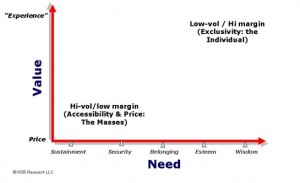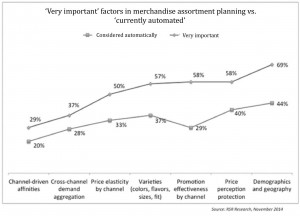Brian Kilcourse is managing partner at Retail Systems Research, San Francisco. This is an edited version of a post that originally appeared here under the title, “Is the customer dimension in merchandise planning over-hyped?”
I remember the first time I ever heard the phrase customer-dimension. The year was 1998 and our IBM account executive had recommended that I meet Mike Blyth, who at the time was a principal at a company called 1.2.1 Marketing (Blyth is now the COO at Aginity, a Chicago-based big data analytics company). Mike’s presentation of his company’s value proposition referenced a book by Don Peppers and Martha Rogers entitled The One To One Future. Essentially, the gist of their position was this: while product-centric marketing focuses on how to maximize the value created by each product, customer-centric marketing focuses on maximizing the value created by each customer. This idea intrigued me so I introduced Mike and his colleagues to our vice president of merchandising. And that is how I started down the customer centricity path.
Since that time, it has become increasingly obvious that retailers must consider the needs of its customers when making assortment decisions at a level of granularity appropriate to the need that the retailer’s brand addresses. If that seems like a mouthful, then consider this chart (apologies to all who have seen it before):
When applied to the notion of customer centricity, what this chart alludes to is that for basic needs, the granularity of customer data needed to make assortment decisions is low, whereas for highly discretionary needs (things that aren’t needed to sustain life but certainly make life a little sweeter), the level of granularity of customer data needed is high, sometimes even approaching one-to-one, just as Peppers and Rogers espoused.
All of that is well and good and at this point in our industry’s evolution most people know that there is no one-size-fits-all for customer-centricity. But consumers threw a significant wrinkle into our thinking about how much customer data is too much when they started using the digital domain in their paths-to-purchase. The reason this is such a big deal is because today it’s not uncommon for consumers to do their investigations and even make product selections outside of the physical domain of the store, and so it’s in retailers’ best interests to get the rightvalue propositions in front of consumers that are most likely to see the value as relevant, at the right moment in each path-to-purchase.
To understand how to do that that effectively, many of today’s retailers are capturing non-transactional data generated during consumers’ digital wanderings (that’s where all that big data is coming from). There’s no question that this kind of information really helps marketers to target value messages to consumers in the digital domain. But there has also been a lot of thinking around the idea that data captured in the digital space can help with assortment planning, as retailers strive to position physical inventory to maximize the profitability of their increasingly important omni-channel fulfillment processes.
Okay, that’s the theory anyway. But we wanted to test just how real that theorizing has become, and so in a study RSR conducted sponsored by JDA, Assortment & Planning: Changing Times, New Opportunities, we asked retailers to rank factors used in assortment planning vs. whether or not consideration of those factors is automated. And here’s what we found out:
Basically, the study responses indicated that those factors that might be considered directly related to consumers’ paths-to-purchase (in particular, “channel-driven affinities” and “cross-channel demand aggregation”) are not highly valued by most retailers and even less automated. The inference is clear: when it comes to using non-transactional big data from the customer dimension for merchandise planning, the drum major is a little too far in front of the marching band.
All of this leads to the inevitable question, are the so-called thought leaders over-hyping the concept of using the customer dimension in merchandise planning? I think not – but it’s early and as I said at the start there is no one-size-fits-all right way to do it. It comes down to what value the brand is fulfilling. For example, while it may not take a lot of customer-centric smarts for a jeweler to know to carry watchbands, it takes a very customer-specific knowledge to know whether to offer Rolex, Breitling, Fossil or Timex at a particular store. While you might argue that all those products exist to help people tell time, in the case of Rolex and Breitling, the value is about esteem. And that implies an intimate knowledge of the local customer base – you certainly don’t want a display full of Rolexes in store if they won’t sell!
That’s pretty intuitive and exactly how most retailers have made such decisions in the past. But in today’s world, the customer is anywhere and the points of fulfillment can be anywhere. So it behooves retailers to try to position inventory in places where the demand can be most profitably fulfilled. That in turn implies knowledge of consumers’ favored paths-to-purchase and that knowledge is generated by data that comes from the customer dimension.
Bottom line: while retailers certainly are well on the way to using the customer dimension appropriately to market to consumers, they have a lot further to go before they unlock the value in that dimension for merchandise planning.


